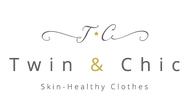Welcome to Twin&Chic Sustainability Journal one more Thursday!
In this fifth installment of our Sustainability Journal our "Guest Editor" will talk to us about the circular transformation of the textile sector.
DELIA GARCÍA GÓMEZ

Sustainability Director of El Corte Inglés .
–
We hope you enjoy our fifth post.
Thank you for being part of the change, together we work for a better future.
#futureisforourchildren
We have an amazing challenge ahead: getting the industry to move from a linear growth model to a circular transformation model.
Every year the European Union produces about 8 million tons of textile waste . Used clothing, but also sheets, rugs, bedspreads, upholstery and a long etcetera. Less than 20% of that amount is recovered in any way. The rest ends up in landfills or is incinerated.
The new European Directive ((EU) 2018/851) which modifies Directive 2008/98/EC and which is transposed into the Spanish legal system through the Law on Waste and Contaminated Soils obliges Member States to begin selective collection of textile waste before January 1, 2025, and to establish objectives regarding the preparation for reuse and recycling of this waste. This will have an impact on the entire textile value chain, as it will be necessary for companies to design their products to contain recycled material and, even more importantly, to allow its reintroduction into the production cycle.
The fashion sector has been timidly venturing into the circular and regenerative economy for years, but it is now that the increase in demand for these more sustainable and planet-friendly products has crept into the strategic plans of companies and institutions for the transformation of the fashion industry with specific deadlines and milestones that leave little room for necessary joint action.
Although the sector is working on a model of RAP [1] , textiles also need to diversify their material sources to face the challenge, given that the textile industry has a high impact on climate change, but also on the protection of the oceans and terrestrial biodiversity. The use of land for cotton cultivation, for example, poses great challenges.
[1] Extended Producer Responsibility
A socioeconomic challenge
Less than 1% of the material used in the manufacture of clothing worldwide is recycled and used to make new garments according to the Circular Fibers Initiative study (it is the so-called upcycling or upcycling), which represents a annual loss of more than $100 billion in materials – And when we talk about circular economy, we are talking about ECONOMY, which we remember, begins with the same root of Greek origin as the word ECOLOGY (Oikos = house).
The real challenge is therefore understand and evaluate the circularity of materials, resources, products and business models to enjoy a healthy economy that imitates the cycle of nature and do not use more resources than you are capable of generating. Thus, from rental and leasing models to the recycling of the fibers themselves, circularity is an essential priority for the survival of the fashion industry.

This is not a chimera, but it will only be possible if companies, governments, researchers and consumers row in the same direction, since one of the main barriers that the sector faces today is the lack of scaling. of solutions.
Other barriers are the lack of applied knowledge of ecodesign and the fracture between different actors in the textile network as well as with other auxiliary sectors, such as the chemical sector.
The good news
Fashion is shaking hands for the first time. Brands are working on alliances strategic both at an international level such as the Fashion Pact or the Ellen MacArthur Foundation's Make Fashion Circular initiative, and at a national level with the Social Fashion Forum or the various working groups on the SCRAP [2] Textile, among others.
However, all actors must be involved. More than 97% of the Spanish business network in the textile and clothing sector are SMEs, according to data from the Ministry of Industry, Tourism and Commerce. Although large companies are driving this necessary circular transformation, it is the SMEs that bear the brunt of it. Many of these SMEs already have a high level of knowledge of circularity because they have been doing it for decades without giving it a name, and there are also specific guides and methodologies such as WAS circular economy guide “from Strategy to Action” especially aimed at SMEs and micro-businesses that want to undertake the journey.
Economic recovery in the post-covid era and the future of human beings on the planet necessarily involves applying circularity to the fashion industry, transforming the entire model without leaving anyone behind to do so. more efficient, more sustainable, more resilient and fairer.
[2] SCRAP = Collective System of Extended Producer Responsibility










Leave a comment